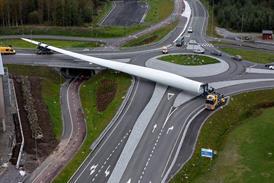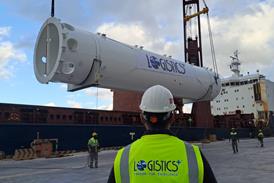There have been calls for increased levels of innovation in the airfreight sector. Drones may find their calling for smaller deliveries on project sites, or in remote surveying; airships could carve a niche in inaccessible areas. Ian Putzger reports.

Cargo drones are about to take to the skies. In early June, Amazon unveiled a vehicle that takes off vertically, then tilts to fly horizontally, equipped with a battery of sensors and artificial intelligence to avoid other objects. It can fly up to 15 miles (24.1 km) and carry items of up to 2.3 kg.
The e-commerce behemoth was set to start trial deliveries “within months”, having obtained a special airworthiness certificate that is valid for one year.
In Canada, commercial cargo drone operations are expected to get under way around October, according to Tim Strauss, vice president of cargo at Air Canada. His outfit signed an agreement with Drone Delivery Canada (DDC) in early June to assume the commercial representation for the drone company, marketing its capacity.
Neither development is going to rock the project cargo world. While Amazon’s drone is designed to lift small parcels, DDC has run trials moving medical shipments and supplies to remote communities in Canada’s north with a model that can carry up to 22.7 kg. Rather than focus on a particular drone model, DDC has developed an operating system akin to an airline operations control set-up that can accommodate a multitude of drones. In the future it will take on drones with larger payloads, said Strauss.
“It is a small plane and a short distance, but it is a start,” said Tim Komberec, president of Empire Airlines. Empire chiefly operates feeder freighters for FedEx and Hawaiian Airlines, but it has also been active in drone development through a dedicated offshoot, Empire Unmanned. To date, this has fielded its models primarily for surveillance work. It recently signed a national firefighting contract that will see its drones operate beyond line of sight to monitor wildfires.
“We are gaining some experience in beyond-line-of-sight work,” said Komberec, who is interested in project work in the longer term.
While surveillance jobs are regarded as one possible use for drones in the project field, Colin d’Abreo, president of Rhenus Project Logistics, reckons they can also move smaller loads within large project sites, such as shuttling tools and parts from base camp to jobsites.
Airship advances
Unlike drones, airships are not ready to start cargo flights this year, but they are getting closer. Lockheed Martin appears to be leading the race at the moment. Hybrid Air Freighters (HAF), its Paris-based operating offshoot, expects to start flying the first LMH-1 airships in 2020 or 2021. The LMH-1 is designed to carry payloads up to 21 tons (19.5 tonnes) in a cargo bay measuring 3.04 m x 3.04 m x 18.3 m.
Flying Whales aims to make the first flight of its LCA60T airship in 2022. The unit will be able to carry up to 60 tons (54.4 tonnes) – far beyond the capability of even large military helicopters, pointed out market manager Romain Schalck. Among the company’s shareholders is the French Forest Authority, which has shaped the development of the aircraft. Aiming to operate in remote wooded areas, the LCA60T is designed to pick up and drop loads via a winch while remaining airborne.
Several other concepts are moving forward, including Aeroscraft’s ML866 blimp that will have a payload capacity of nearly 60 tons; the company has plans for enhanced models capable of lifting 181 tons (163.3 tonnes) and 450 tons (408.2 tonnes). UK-based Airlander is also developing an airship, although the initial focus appears to be towards the cruise and travel markets.
“At this point nobody knows what will be the dominant design,” said Barry Prentice, president of Canada-based Buoyant Aircraft Systems International, which signed a collaboration agreement with Airships do Brasil last year to build a 100-ton (90.7-tonne) capacity cargo airship.
He thinks that airships have moved from “nice to have” to the “need to have” stage. He gave the example of northern Canada, where increasing temperatures have limited the time ice roads can be used; the astronomical costs of moving goods to remote communities; and the difficulties involved in moving large wind turbine blades over the surface. Airships could move blades that are twice the current maximum size allowed on the ground, he argued.
With the exception of Airlander, the leading airship developers have cargo fully in their sights, and the project sector is most prominent there. “We are working closely with industries,” said Schalck. “The most advanced relationships we have today are with the wind energy industry, both with manufacturers and wind farm developers.
We are working closely with the major players in Europe and North America.”
The oil and gas sector has also shown lively interest, he added.
For electricity companies, the airship also opens up attractive possibilities. Besides carrying large loads like cable reels, they will be able to lift entire electricity towers, which currently have to be moved in sections, Schalck said.
HAF and Columbia Helicopters, which signed a collaboration agreement last November for the management and operation of 12 LMH-1s, are looking primarily to the oil and gas, mining and construction sectors.
More options
For his part, d’Abreo welcomes the prospect of more options to move project loads. “In project logistics it is time we had some innovation or some different solutions in terms of airfreight transport. The Antonovs and Ilyushins will always be needed for super-heavy cargo, but for mid-to not-so- heavy [cargoes], airships could be an option,” he commented. They would be ideal to reach hard-to-access locations like mountaintops and for offshore sites.
HAF has indicated that it sees a market for several hundred airships. Current plans at Flying Whales call for 150 units to be produced during the first ten years.
Among its shareholders is AVIC, a Chinese aerospace and defence conglomerate. When commercial activities get under way, the LCA60T will be produced both in France and in China.
Turning out airships is only part of the battle, though. At this point there are only a few pilots available, Schalck said. Flying Whales intends to set up its own pilot school.
Jurisdictions like Canada lack certification processes for pilots and mechanics as well as for airships themselves, noted Prentice. Flying Whales has worked closely with the authorities in Europe and hopes that certification there will pave the way for accreditation elsewhere around the world.
Prentice believes that stand-alone operators will have to emerge over time. Initially developers may have to set up their own operating arms to get commercial activities under way, but in the long run he sees a need for operators in their own right. “Developing and operating airships are two different things,” he said.
The fact that such questions are now being asked reflects the progress that the airship concept has made in recent years.
This article is taken from HLPFI’s July/August 2019 edition.
















